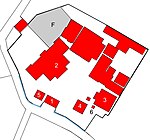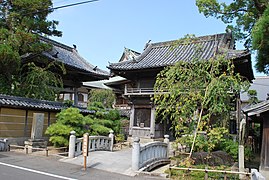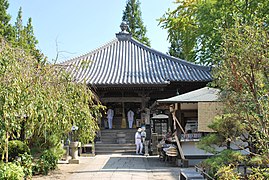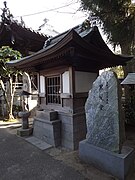Tatsue-ji (Komatsushima)
The Tatsue-ji ( Japanese 立 江 寺 ) with the Go Kyōchisan (橋 池 山) and Maniin (摩尼 院) in Komatsushima is a temple that belongs to the Kōyasan branch (高 野山 派) of Shingon Buddhism . In the traditional count, it is the 19th temple on the Shikoku pilgrimage route .
history
The temple was built at the request of the Emperor Shōmu by the priest Gyōgi during the Tempyō era. Gyōgi made on this occasion a 5.5 cm tall figure of Jizō Bosatsu from a gold alloy (閻浮 壇 金, Embudankin) to mark a happy confinement of his wife, the Empress Kōmyō (光明 皇后, Kōmyō-kōgō; 701-760), to guarantee.
In 815, Priest Kūkai came to the temple on his trek through Shikoku . Fearing that the too small Jizo might get lost, he created a 6 foot, 181 cm high Jizo statue. He is said to have housed the little Jizō inside the new figure, which has now been revered. In fact, the current jizō dates from the Kamakura period .
The temple was originally located about 500 m further west at the foot of Mount Shimizuokutani (清水 奥 谷 山), but was destroyed during the military unrest during the Tenshō era (1573–1592) by troops of Chōsokabe Motochika when he invaded the province of Awa , destroyed. In the Edo period , Prince Hachisuka Iemasa (蜂 須 賀 家政; 1558–1639) is said to have rebuilt the temple at its current location. The main hall, built in 1659, was lost in a fire in 1974 and was then rebuilt in 1977.
investment
You enter the complex through the temple gate, which is designed as a Nio gate ( 仁王 門 , Niō-mon; 1), i.e. as a gate with the two temple guards to the right and left of the passage. On the left you can see the main hall ( 本 堂 , Hondō; 2), on the far left of the gate the temple bell ( 鐘楼 , Shōrō; 5). On the right you have the treasure pagoda ( 多 宝塔 , Tahōtō; 4) in the green and the hall dedicated to the temple founder, the Daishidō ( 大師 堂 ; 3).
There is also the Gomadō ( 護 摩 堂 ), in which the Goma ceremony is held, and the tiny Kokuhatsudō ( 黒 髪 堂 ; 6), in German about "Black Hair Shrine", which has been a reminder of the fate of the geisha Okyō since 1803 . Finally, the temple has a cemetery (F) in the north of the complex.
Treasures
One of the temple treasures is the colored representation of a Shaka trinity (絹本 著色 釈 迦 三 尊像, Kempon chakushiki Shaka sanzon-zō), consisting of Shaka Nyorai (釈 迦 如 来), flanked to the left by the joint riding a white elephant with folded hands Bosatsu (普賢 菩薩) and to the right of Monju Bosatsu (文殊 菩薩), who is riding a lion and holding a box with scriptures and a sword in his hand. The piece is registered as an Important Cultural Property of Japan .
photos
Remarks
- ↑ In the small shrine, the bells from the hair ornaments and hair of Okyō ( お 京 ), a girl who was sold to Osaka as a geisha by her parents , are kept. Okyō, involved in a murder, came to this temple on the run in 1748. When she prayed to holy Jizō, her hair stood on end. A priest could eventually obtain forgiveness for them.
literature
- Tokushima-ken no rekishi sampo henshu iinkai (ed.): Tatsue-ji . In: Tokushima-ken no rekishi sampo. Yamakawa Shuppan, 2009. ISBN 978-4-634-24636-2 . Pages 204 to 205.
- Oguri, Doei: Kukai. Shikoku hachijuhachi kosho no arukikata. Chukei no Bunko, 2011. ISBN 978-4-8061-4067-2 .
Web links
Coordinates: 33 ° 58 ′ 4.3 " N , 134 ° 36 ′ 20.9" E
← Previous Temple: Onzan-ji | Tatsue-ji (Komatsushima) | Next temple: Kakurin-ji →







